albuterol sulfate hfa (Albuterol Sulfate) aerosol, metered
[IVAX Research Inc.]
DESCRIPTION
The active ingredient of Albuterol Sulfate HFA Inhalation Aerosol is albuterol sulfate, a racemic salt, which is a relatively selective beta2-adrenergic bronchodilator. Albuterol sulfate has the chemical name α1-[(tert-butylamino) methyl]-4-hydroxy-m-xylene-α,α'-diol sulfate (2:1) (salt), and has the following chemical structure:
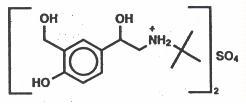
The molecular weight of albuterol sulfate is 576.7, and the empirical formula is (C13H21NO3)2•H2SO4. Albuterol sulfate is a white to off-white crystalline powder. It is soluble in water and slightly soluble in ethanol. Albuterol Sulfate HFA Inhalation Aerosol is a pressurized metered-dose aerosol unit for oral inhalation. It contains a microcrystalline suspension of albuterol sulfate in propellant HFA-134a (1,1,1,2-tetrafluoroethane) and ethanol.
Each actuation delivers 120 mcg albuterol sulfate, from the canister valve and 108 mcg albuterol sulfate, from the actuator mouthpiece (equivalent to 90 mcg of albuterol base from the mouthpiece). Each canister provides 200 inhalations. It is recommended to prime the inhaler before using for the first time and in cases where the inhaler has not been used for more than 2 weeks by releasing three “test sprays” into the air, away from the face.
This product does not contain chlorofluorocarbons (CFCs) as the propellant.
CLINICAL PHARMACOLOGY
Mechanism of Action
In vitro studies and in vivo pharmacologic studies have demonstrated that albuterol has a preferential effect on beta2-adrenergic receptors compared with isoproterenol. While it is recognized that beta2-adrenergic receptors are the predominant receptors on bronchial smooth muscle, data indicate that there is a population of beta2-receptors in the human heart existing in a concentration between 10% and 50% of total cardiac beta-adrenergic receptors. The precise function of these receptors has not been established (see WARNINGS for Cardiovascular Effects).
Activation of beta2-adrenergic receptors on airway smooth muscle leads to the activation of adenylcyclase and to an increase in the intracellular concentration of cyclic-3',5’-adenosine monophosphate (cyclic AMP). This increase of cyclic AMP leads to the activation of protein kinase A, which inhibits the phosphorylation of myosin and lowers intracellular ionic calcium concentrations, resulting in relaxation. Albuterol relaxes the smooth muscle of all airways, from the trachea to the terminal bronchioles. Albuterol acts as a functional antagonist to relax the airway irrespective of the spasmogen involved, thus protecting against all bronchoconstrictor challenges. Increased cyclic AMP concentrations are also associated with the inhibition of release of mediators from mast cells in the airway.
Albuterol has been shown in most clinical trials to have more effect on the respiratory tract, in the form of bronchial smooth muscle relaxation, than isoproterenol at comparable doses while producing fewer cardiovascular effects. Controlled clinical studies and other clinical experience have shown that inhaled albuterol, like other beta-adrenergic agonist drugs, can produce a significant cardiovascular effect in some patients, as measured by pulse rate, blood pressure, symptoms, and/or electrocardiographic changes.
Preclinical
Intravenous studies in rats with albuterol sulfate have demonstrated that albuterol crosses the blood-brain barrier and reaches brain concentrations amounting to approximately 5% of the plasma concentrations. In structures outside the blood-brain barrier (pineal and pituitary glands), albuterol concentrations were found to be 100 times those in the whole brain.
Studies in laboratory animals (minipigs, rodents, and dogs) have demonstrated the occurrence of cardiac arrhythmias and sudden death (with histologic evidence of myocardial necrosis) when β-agonists and methylxanthines were administered concurrently. The clinical significance of these findings is unknown.
Propellant HFA-134a is devoid of pharmacological activity except at very high doses in animals (380-1300 times the maximum human exposure based on comparisons of AUC values), primarily producing ataxia, tremors, dyspnea, or salivation. These are similar to effects produced by the structurally related chlorofluorocarbons (CFCs), which have been used extensively in metered-dose inhalers.
In animals and humans, propellant HFA-134a was found to be rapidly absorbed and rapidly eliminated, with an elimination half-life of 3-27 minutes in animals and 5-7 minutes in humans. Time to maximum plasma concentration (Tmax) and mean residence time are both extremely short leading to a transient appearance of HFA-134a in the blood with no evidence of accumulation.
Pharmacokinetics
The systemic levels of albuterol are low after inhalation of recommended doses. In a crossover study conducted in healthy male and female volunteers, high cumulative doses of Albuterol Sulfate HFA Inhalation Aerosol (1,080 mcg of albuterol base administered over one hour) yielded mean peak plasma concentrations (Cmax) and systemic exposure (AUCinf) of approximately 4,100 pg/mL and 28,426 pg.hr/mL, respectively compared to approximately 3,900 pg/mL and 28,395 pg.hr/mL, respectively following the same dose of an active HFA-134a albuterol inhaler comparator. The terminal plasma half-life of albuterol delivered by Albuterol Sulfate HFA Inhalation Aerosol was approximately 6 hours. Comparison of the pharmacokinetic parameters demonstrated no differences between the products.
No pharmacokinetic studies for Albuterol Sulfate HFA Inhalation Aerosol have been conducted in neonates, children, or elderly subjects.
Clinical Trials
In a 6-week, randomized, evaluator-blind, placebo-controlled trial, Albuterol Sulfate HFA Inhalation Aerosol (58 patients) was compared to an HFA-134a placebo inhaler (58 patients) in asthmatic patients 12 to 76 years of age at a dose of 180 mcg albuterol four times daily. An active comparator HFA-134a albuterol inhaler arm (56 patients) was included.
Serial FEV1 measurements, shown below as percent change from test-day baseline at Day 1 and at Day 43, demonstrated that two inhalations of Albuterol Sulfate HFA Inhalation Aerosol produced significantly greater improvement in FEV1 over the pre-treatment value than placebo, as well as a comparable bronchodilator effect to the active comparator HFA-134a albuterol inhaler.
The mean time of onset of a 15% increase in FEV1 at Day 1 was approximately 19 minutes and the mean time to peak effect was 70 minutes. The mean duration of effect as measured by a 15% increase in FEV1 over the pre-treatment value was approximately 3 hours. In some patients, the duration was as long as 6 hours.
In a placebo-controlled single-dose, crossover study in which Albuterol Sulfate HFA Inhalation Aerosol, administered at albuterol doses of 90, 180 and 270 mcg, produced bronchodilator responses significantly greater than those observed with an HFA-134a placebo inhaler and comparable to an active comparator HFA-134a albuterol inhaler.
Some patients who participated in these clinical trials were using concomitant steroid therapy.
FEV1 as Mean Percent Change from Test-Day Pre-Dose in a 6-Week Clinical Trial
Day 1
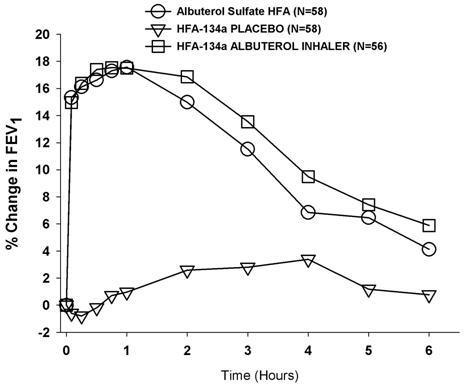
Day 43
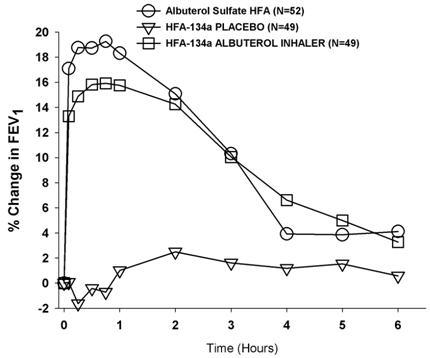
INDICATIONS AND USAGE
Albuterol Sulfate HFA Inhalation Aerosol is indicated in adults and children 12 years of age and older for the treatment or prevention of bronchospasm with reversible obstructive airway disease.
CONTRAINDICATIONS
Albuterol Sulfate HFA Inhalation Aerosol is contraindicated in patients with a history of hypersensitivity to albuterol and any other Albuterol Sulfate HFA Inhalation Aerosol components.
WARNINGS
Paradoxical Bronchospasm
Inhaled albuterol sulfate can produce paradoxical bronchospasm that may be life threatening. If paradoxical bronchospasm occurs, Albuterol Sulfate HFA Inhalation Aerosol should be discontinued immediately and alternative therapy instituted. It should be recognized that paradoxical bronchospasm, when associated with inhaled formulations, frequently occurs with the first use of a new canister.
Deterioration of Asthma
Asthma may deteriorate acutely over a period of hours or chronically over several days or longer. If the patient needs more doses of Albuterol Sulfate HFA Inhalation Aerosol than usual, this may be a marker of destabilization of asthma and requires re-evaluation of the patient and treatment regimen, giving special consideration to the possible need for anti-inflammatory treatment, e.g., corticosteroids.
Use of Anti-inflammatory Agents
The use of beta-adrenergic-agonist bronchodilators alone may not be adequate to control asthma in many patients. Early consideration should be given to adding anti-inflammatory agents, e.g., corticosteroids, to the therapeutic regimen.
Cardiovascular Effects
Albuterol Sulfate HFA Inhalation Aerosol, like other beta-adrenergic agonists, can produce clinically significant cardiovascular effects in some patients as measured by pulse rate, blood pressure, and/or symptoms. Although such effects are uncommon after administration of Albuterol Sulfate HFA Inhalation Aerosol at recommended doses, if they occur, the drug may need to be discontinued. In addition, beta-agonists have been reported to produce ECG changes, such as flattening of the T wave, prolongation of the QTc interval, and ST segment depression. The clinical significance of these findings is unknown. Therefore, Albuterol Sulfate HFA Inhalation Aerosol, like all sympathomimetic amines, should be used with caution in patients with cardiovascular disorders, especially coronary insufficiency, cardiac arrhythmias, and hypertension.
Do Not Exceed Recommended Dose
Fatalities have been reported in association with excessive use of inhaled sympathomimetic drugs in patients with asthma. The exact cause of death is unknown, but cardiac arrest following an unexpected development of a severe acute asthmatic crisis and subsequent hypoxia is suspected.
Immediate Hypersensitivity Reactions
Immediate hypersensitivity reactions may occur after administration of albuterol sulfate, as demonstrated by rare cases of urticaria, angioedema, rash, bronchospasm, anaphylaxis, and oropharyngeal edema.
PRECAUTIONS
General
Albuterol sulfate, as with all sympathomimetic amines, should be used with caution in patients with cardiovascular disorders, especially coronary insufficiency, cardiac arrhythmias, and hypertension; in patients with convulsive disorders, hyperthyroidism, or diabetes mellitus; and in patients who are unusually responsive to sympathomimetic amines. Clinically significant changes in systolic and diastolic blood pressure have been seen in individual patients and could be expected to occur in some patients after use of any beta-adrenergic bronchodilator.
Large doses of intravenous albuterol have been reported to aggravate preexisting diabetes mellitus and ketoacidosis. As with other beta-agonists, albuterol may produce significant hypokalemia in some patients, possibly through intracellular shunting, which has the potential to produce adverse cardiovascular effects. The decrease is usually transient, not requiring supplementation.
Information for Patients
See illustrated Patient's Instructions for Use. SHAKE WELL BEFORE USING. Patients should be given the following information:
It is recommended to prime the inhaler before using for the first time and in cases where the inhaler has not been used for more than 2 weeks by releasing three “test sprays” into the air, away from the face.
KEEPING THE PLASTIC MOUTHPIECE CLEAN IS VERY IMPORTANT TO PREVENT MEDICATION BUILD-UP AND BLOCKAGE. THE MOUTHPIECE SHOULD BE WASHED, SHAKEN TO REMOVE EXCESS WATER, AND AIR DRIED THOROUGHLY AT LEAST ONCE A WEEK. THE INHALER MAY CEASE TO DELIVER MEDICATION IF NOT PROPERLY CLEANED.
The mouthpiece should be cleaned (with the canister removed) by running warm water through the top and bottom of the mouthpiece for 30 seconds at least once a week. The mouthpiece must be shaken to remove excess water, then air-dried thoroughly (such as overnight). Blockage from medication build-up or improper medication delivery may result from failure to thoroughly air dry the mouthpiece.
If the mouthpiece should become blocked (little or no medication coming out of the mouthpiece), the blockage may be removed by washing as described above.
If it is necessary to use the inhaler before it is completely dry, shake off excess water, replace canister, test spray twice away from face, and take the prescribed dose. After such use, the mouthpiece should be rewashed and allowed to air dry thoroughly.
The action of Albuterol Sulfate HFA Inhalation Aerosol lasts up to 4 to 6 hours. Albuterol Sulfate HFA Inhalation Aerosol should not be used more frequently than recommended. Do not increase the dose or frequency of doses of Albuterol Sulfate HFA Inhalation Aerosol without consulting your physician. If you find that treatment with Albuterol Sulfate HFA Inhalation Aerosol becomes less effective for symptomatic relief, your symptoms become worse, and/or you need to use the product more frequently than usual, seek medical attention immediately. While you are taking Albuterol Sulfate HFA Inhalation Aerosol, other inhaled drugs and asthma medications should be taken only as directed by your physician. If you are pregnant or nursing, contact your physician about the use of Albuterol Sulfate HFA Inhalation Aerosol.
Common adverse effects of treatment with inhaled albuterol include palpitations, chest pain, rapid heart rate, tremor, or nervousness. If you are pregnant or nursing, contact your physician about use of Albuterol Sulfate HFA Inhalation Aerosol. Effective and safe use of Albuterol Sulfate HFA Inhalation Aerosol includes an understanding of the way that it should be administered. Use Albuterol Sulfate HFA Inhalation Aerosol only with the actuator supplied with the product. Discard the canister after 200 sprays have been used.
Drug Interactions
Other short-acting sympathomimetic aerosol bronchodilators should not be used concomitantly with albuterol. If additional adrenergic drugs are to be administered by any route, they should be used with caution to avoid deleterious cardiovascular effects.
Beta-Blockers
Beta-adrenergic-receptor blocking agents not only block the pulmonary effect of beta-agonists, such as Albuterol Sulfate HFA Inhalation Aerosol, but may produce severe bronchospasm in asthmatic patients. Therefore, patients with asthma should not normally be treated with beta-blockers. However, under certain circumstances, e.g., as prophylaxis after myocardial infarction, there may be no acceptable alternatives to the use of beta-adrenergic-blocking agents in patients with asthma. In this setting, cardioselective beta-blockers should be considered, although they should be administered with caution.
Diuretics
The ECG changes and/or hypokalemia which may result from the administration of non-potassium sparing diuretics (such as loop or thiazide diuretics) can be acutely worsened by beta-agonists, especially when the recommended dose of the beta-agonist is exceeded. Although the clinical significance of these effects is not known, caution is advised in the coadministration of beta-agonists with non-potassium sparing diuretics.
Digoxin
Mean decreases of 16% and 22% in serum digoxin levels were demonstrated after single dose intravenous and oral administration of albuterol, respectively, to normal volunteers who had received digoxin for 10 days. The clinical significance of these findings for patients with obstructive airway disease who are receiving albuterol and digoxin on a chronic basis is unclear. Nevertheless, it would be prudent to carefully evaluate the serum digoxin levels in patients who are currently receiving digoxin and albuterol.
Monoamine Oxidase Inhibitors or Tricyclic Antidepressants
Albuterol Sulfate HFA Inhalation Aerosol should be administered with extreme caution to patients being treated with monoamine oxidase inhibitors or tricyclic antidepressants, or within 2 weeks of discontinuation of such agents, because the action of albuterol on the cardiovascular system may be potentiated.
Carcinogenesis, Mutagenesis, Impairment of Fertility
In a 2-year study in Sprague-Dawley rats, albuterol sulfate caused a dose-related increase in the incidence of benign leiomyomas of the mesovarium at and above dietary doses of 2 mg/kg (approximately 15 times the maximum recommended daily inhalation dose for adults on a mg/m2 basis). In another study this effect was blocked by the coadministration of propranolol, a non-selective beta-adrenergic antagonist. In an 18-month study in CD-1 mice, albuterol sulfate showed no evidence of tumorigenicity at dietary doses of up to 500 mg/kg (approximately 1,600 times the maximum recommended daily inhalation dose for adults on a mg/m2 basis). In a 22-month study in Golden Hamsters, albuterol sulfate showed no evidence of tumorigenicity at dietary doses of up to 50 mg/kg (approximately 210 times the maximum recommended daily inhalation dose for adults on a mg/m2 basis).
Albuterol sulfate was not mutagenic in the Ames test or a mutation test in yeast. Albuterol sulfate was not clastogenic in a human peripheral lymphocyte assay or in an AH1 strain mouse micronucleus assay.
Reproduction studies in rats demonstrated no evidence of impaired fertility at oral doses up to 50 mg/kg (approximately 310 times the maximum recommended daily inhalation dose for adults on a mg/m2 basis).
Pregnancy
Teratogenic Effects: Pregnancy Category C
Albuterol sulfate has been shown to be teratogenic in mice. A study in CD-1 mice given albuterol sulfate subcutaneously showed cleft palate formation in 5 of 111 (4.5%) fetuses at 0.25 mg/kg (less than the maximum recommended daily inhalation dose for adults on a mg/m2 basis) and in 10 of 108 (9.3%) fetuses at 2.5 mg/kg (approximately 8 times the maximum recommended daily inhalation dose for adults on a mg/m2 basis). The drug did not induce cleft palate formation at the low dose 0.025 mg/kg (less than the maximum recommended daily inhalation dose for adults on a mg/m2 basis). Cleft palate also occurred in 22 of 72 (30.5%) fetuses treated subcutaneously with 2.5 mg/kg isoproterenol (positive control).
A reproduction study in Stride Dutch rabbits revealed cranioschisis in 7 of 19 (37%) fetuses when albuterol sulfate was administered orally at 50 mg/kg (approximately 630 times the maximum recommended daily inhalation dose for adults on a mg/m2 basis).
In an inhalation reproduction study in Sprague-Dawley rats, the albuterol sulfate/HFA-134a formulation did not exhibit any teratogenic effects at 10.5 mg/kg (approximately 65 times the maximum recommended daily inhalation dose for adults on a mg/m2 basis).
A study in which pregnant rats were dosed with radiolabeled albuterol sulfate demonstrated that drug-related material is transferred from the maternal circulation to the fetus.
There are no adequate and well-controlled studies of albuterol sulfate in pregnant women. Albuterol Sulfate HFA Inhalation Aerosol should be used during pregnancy only if the potential benefit justifies the potential risk to the fetus.
During worldwide marketing experience, various congenital anomalies, including cleft palate and limb defects, have been reported in the offspring of patients being treated with albuterol. Some of the mothers were taking multiple medications during their pregnancies. Because no consistent pattern of defects can be discerned, a relationship between albuterol use and congenital anomalies has not been established.
Use in Labor and Delivery
Because of the potential for beta-agonist interference with uterine contractility, use of Albuterol Sulfate HFA Inhalation Aerosol for relief of bronchospasm during labor should be restricted to those patients in whom the benefits clearly outweigh the risk.
Tocolysis
Albuterol has not been approved for the management of pre-term labor. The benefit:risk ratio when albuterol is administered for tocolysis has not been established. Serious adverse reactions, including pulmonary edema, have been reported during or following treatment of premature labor with beta2-agonists, including albuterol.
Nursing Mothers
Plasma levels of albuterol sulfate and HFA-134a after inhaled therapeutic doses are very low in humans, but it is not known whether the components of Albuterol Sulfate HFA Inhalation Aerosol are excreted in human milk.
Caution should be exercised when albuterol sulfate is administered to a nursing woman. Because of the potential for tumorigenicity shown for albuterol in animal studies and lack of experience with the use of Albuterol Sulfate HFA Inhalation Aerosol by nursing mothers, a decision should be made whether to discontinue nursing or to discontinue the drug, taking into account the importance of the drug to the mother.
Pediatrics
The safety and effectiveness of Albuterol Sulfate HFA Inhalation Aerosol in pediatric patients below the age of 12 years have not been established.
Geriatrics
Clinical studies of Albuterol Sulfate HFA Inhalation Aerosol did not include sufficient numbers of patients aged 65 and over to determine whether they respond differently from younger patients. Other reported clinical experience has not identified differences in responses between elderly and younger patients. In general, dose selection for an elderly patient should be cautious, usually starting at the low end of the dosing range, reflecting the greater frequency of decreased hepatic, renal, or cardiac function, and of concomitant disease or other drug therapy.
ADVERSE REACTIONS
A total of 973 subjects were treated with Albuterol Sulfate HFA Inhalation Aerosol during the worldwide clinical development program.
The adverse reaction information presented in the table below concerning Albuterol Sulfate HFA Inhalation Aerosol is derived from a 6-week, evaluator-blind study which compared Albuterol Sulfate HFA Inhalation Aerosol (180 mcg four times daily) with an HFA-134a placebo inhaler and an active comparator HFA-134a albuterol inhaler in 172 asthmatic patients 12 to 76 years of age. The table lists the incidence of all adverse events (whether considered by the investigator drug related or unrelated to drug) from this study which occurred at a rate of 3% or greater in the Albuterol Sulfate HFA Inhalation Aerosol treatment group and more frequently in the Albuterol Sulfate HFA Inhalation Aerosol treatment group than in the placebo group. Overall, the incidence and nature of the adverse events reported for Albuterol Sulfate HFA Inhalation Aerosol and the active comparator HFA-134a albuterol inhaler were comparable.
| Body System/ Adverse Event (as Preferred Term) |
Albuterol Sulfate Inhalation Aerosol |
Active comparator HFA-134a Albuterol Inhaler | HFA-134a Placebo Inhaler | |
|---|---|---|---|---|
| (N = 58) | (N = 56) | (N = 58) | ||
| * This table includes all adverse events (whether considered by the investigator drug related or unrelated to drug) which occurred at an incidence rate of at least 3.0% in the Albuterol Sulfate HFA Inhalation Aerosol group and more frequently in the Albuterol Sulfate HFA Inhalation Aerosol group than in the HFA-134a placebo inhaler group. | ||||
| Body as a Whole | Headache | 7 | 5 | 2 |
| Cardiovascular | Tachycardia | 3 | 2 | 0 |
| Musculoskeletal | Pain | 3 | 0 | 0 |
| Nervous System | Dizziness | 3 | 0 | 0 |
| Respiratory | Pharyngitis | 14 | 7 | 9 |
| System | Rhinitis | 5 | 4 | 2 |
Adverse events reported by less than 3% of the patients receiving Albuterol Sulfate HFA Inhalation Aerosol but by a greater proportion of Albuterol Sulfate HFA Inhalation Aerosol patients than placebo patients, which have the potential to be related to Albuterol Sulfate HFA Inhalation Aerosol, included chest pain, infection, diarrhea, glossitis, accidental injury (nervous system), anxiety, dyspnea, ear disorder, ear pain, and urinary tract infection. Adverse events reported by 3% or more patients receiving Albuterol Sulfate and by an equal or lesser proportion of Albuterol Sulfate HFA Inhalation Aerosol patients than placebo patients included asthma, back pain, increased cough and infection (respiratory).
The most frequent adverse events occurring in three studies conducted in 32 volunteers or 25 asthmatics in which Albuterol Sulfate HFA Inhalation Aerosol was administered as single cumulative albuterol doses of up to 1080 mcg over an hour (volunteers) or 1350 mcg over 1½ hours (asthmatics) were consistent with those associated with high-dose inhaled albuterol and included tremor, nervousness, and headache.
Rare cases of urticaria, angioedema, rash, bronchospasm, hoarseness, oropharyngeal edema, and arrhythmias (including atrial fibrillation, supraventricular tachycardia, extrasystoles) have been reported after the use of inhaled albuterol. In addition, albuterol, like other sympathomimetic agents, can cause adverse reactions such as hypertension, angina, vertigo, central nervous system stimulation, insomnia, headache, and drying or irritation of the oropharynx.
OVERDOSAGE
The expected symptoms with overdosage are those of excessive beta-adrenergic stimulation and/or occurrence or exaggeration of any of the symptoms listed under ADVERSE REACTIONS, e.g., seizures, angina, hypertension or hypotension, tachycardia with rates up to 200 beats per minute, arrhythmias, nervousness, headache, tremor, dry mouth, palpitation, nausea, dizziness, fatigue, malaise, and insomnia.
Hypokalemia may also occur. As with all sympathomimetic medications, cardiac arrest and even death may be associated with abuse of Albuterol Sulfate HFA Inhalation Aerosol.
Treatment consists of discontinuation of Albuterol Sulfate HFA Inhalation Aerosol together with appropriate symptomatic therapy. The judicious use of a cardioselective beta-receptor blocker may be considered, bearing in mind that such medication can produce bronchospasm. There is insufficient evidence to determine if dialysis is beneficial for overdosage of Albuterol Sulfate HFA Inhalation Aerosol.
The oral median lethal dose of albuterol sulfate in mice is greater than 2,000 mg/kg (approximately 6,300 times the maximum recommended daily inhalation dose for adults on a mg/m2 basis). In mature rats, the subcutaneous median lethal dose of albuterol sulfate is approximately 450 mg/kg (approximately 2,800 times the maximum recommended daily inhalation dose for adults on a mg/m2 basis). In young rats, the subcutaneous median lethal dose is approximately 2,000 mg/kg (approximately 13,000 times the maximum recommended daily inhalation dose for adults on a mg/m2 basis). The inhalation median lethal dose has not been determined in animals.
DOSAGE AND ADMINISTRATION
For treatment of acute episodes of bronchospasm or prevention of asthmatic symptoms, the usual dosage for adults and children 12 years and older is two inhalations repeated every 4 to 6 hours. More frequent administration or a larger number of inhalations is not recommended. In some patients, one inhalation every 4 hours may be sufficient.
Each actuation of Albuterol Sulfate HFA Inhalation Aerosol delivers 108 mcg of albuterol sulfate (equivalent to 90 mcg of albuterol base) from the actuator mouthpiece. It is recommended to prime the inhaler before using for the first time and in cases where the inhaler has not been used for more than two weeks by releasing three “test sprays” into the air, away from the face.
If a previously effective dosage regimen fails to provide the usual response, this may be a marker of destabilization of asthma and requires re-evaluation of the patient and the treatment regimen, giving special consideration to the possible need for anti-inflammatory treatment, e.g., corticosteroids.
To maintain proper use of this product and to prevent medication build-up and blockage, it is important to keep the plastic mouthpiece clean. Wash the mouthpiece and air dry thoroughly at least once a week. If the mouthpiece becomes blocked, washing the mouthpiece will remove the blockage. The inhaler may cease to deliver medication if not properly cleaned and air dried. See- Information For Patients.
HOW SUPPLIED
Albuterol Sulfate HFA Inhalation Aerosol is supplied as a pressurized aluminum canister with a red plastic actuator and white dust cap each in boxes of one. Each canister contains 8.5 g of the formulation and provides 200 actuations (NDC 59310-579-20). Each actuation delivers 120 mcg of albuterol sulfate from the canister valve and 108 mcg of albuterol sulfate from the actuator mouthpiece (equivalent to 90 mcg of albuterol base).
Rx only.
Store between 15°and 25°C (59° and 77°F). Avoid exposure to extreme heat and cold. For best results, canister should be at room temperature before use.
SHAKE WELL BEFORE USE
The red actuator supplied with Albuterol Sulfate HFA Inhalation Aerosol should not be used with the canister from any other inhalation aerosol products. The Albuterol Sulfate HFA Inhalation Aerosol canister should not be used with the actuator from any other inhalation aerosol products.
Once the labeled number of actuations (i.e. 200) has been used, the labeled amount of medication delivered from a canister cannot be assured. As a result, the inhaler should be discarded after 200 actuations, even though the canister may not be completely empty. Never immerse the canister into water to determine how full the canister is (“float test”).
WARNING:
Avoid spraying in eyes. Contents under pressure. Do not puncture or incinerate. Exposure to temperatures above 120°F may cause bursting. Keep out of reach of children.
Albuterol Sulfate HFA Inhalation Aerosol does not contain chlorofluorocarbons (CFCs) as the propellant.
Manufactured By:
IVAX Pharmaceuticals Ireland
Waterford, Ireland
For:
IVAX Laboratories, Inc.
Miami, FL 33137 USA
Copyright ©2004, IVAX Laboratories, Inc.
All rights reserved.
Rev. 11/04
PE1521
SUPPLEMENTAL PATIENT MATERIAL
Attention Pharmacist:
Detach Patient’s Instructions for use from package insert and dispense with the product.
Albuterol SulfateHFA
Inhalation Aerosol
FOR ORAL INHALATION ONLY
Patient’s Instructions For Use
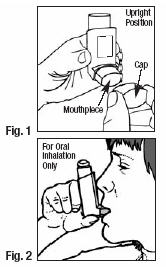
Before using your Albuterol Sulfate HFA Inhalation Aerosol, read complete instructions carefully. Children should use Albuterol Sulfate HFA Inhalation Aerosol, under adult supervision, as instructed by the patient’s doctor.
This inhalation aerosol does not contain chlorofluorocarbons (CFCs) as the propellant and is therefore CFC free.
-
SHAKE THE INHALER WELL immediately before each use. Then remove the cap from the mouthpiece (see Figure 1). Check mouthpiece for foreign objects prior to use. Make sure the canister is fully inserted into the actuator.
-
As with all aerosol medications, it is recommended to prime the inhaler before using for the first time and in cases where the inhaler has not been used for more than 2 weeks. Prime by releasing three “test sprays” into the air, away from your face.
-
BREATHE OUT FULLY THROUGH THE MOUTH, expelling as much air from your lungs as possible. Place the mouthpiece fully into your mouth holding the inhaler in its upright position and closing your lips around it (see Figure 2). Make sure your tongue is placed below the mouthpiece.
-
WHILE BREATHING IN DEEPLY AND SLOWLY THROUGH THE MOUTH, FULLY DEPRESS AND THEN IMMEDIATELY RELEASE THE TOP OF THE METAL CANISTER with your index finger (See Figure 2.)
-
HOLD YOUR BREATH AS LONG AS POSSIBLE, up to 10 seconds. Before breathing out, remove the inhaler from your mouth and release your finger from the canister.
-
If your doctor has prescribed additional puffs, wait one minute, shake the inhaler again and repeat steps 3 through 5. Replace the cap after use.
-
KEEPING THE PLASTIC MOUTHPIECE CLEAN IS EXTREMELY IMPORTANT TO PREVENT MEDICATION BUILD-UP AND BLOCKAGE (CLOGGED). THE MOUTHPIECE SHOULD BE WASHED, SHAKEN TO REMOVE EXCESS WATER, AND AIR-DRIED THOROUGHLY AT LEAST ONCE PER WEEK. INHALER MAY STOP SPRAYING IF NOT PROPERLY CLEANED.
Routine cleaning instructions: Step 1. Wash at least once a week. To clean, remove the canister and mouthpiece cap. Wash the mouthpiece through the top and bottom with warm running water for 30 seconds (see Figure A). Never immerse the metal canister in water.
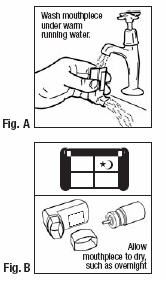
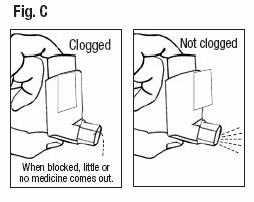
Step 2. To dry, shake off excess water and let the mouthpiece air dry thoroughly, such as overnight (see figure B). When the mouthpiece is dry, replace the canister and the mouthpiece cap. Blockage from medication build-up is more likely to occur if the mouthpiece is not allowed to air dry thoroughly.
IF YOUR INHALER BECOMES BLOCKED OR CLOGGED (little or no medication coming out of the mouthpiece, see Figure C), wash the mouthpiece as described in Step 1 and air dry properly as described in Step 2.
IF YOU NEED TO USE YOUR INHALER BEFORE IT IS COMPLETELY DRY, SHAKE, OFF EXCESS WATER, replace the canister, and test spray twice into the air, away from your face, to remove most of the remaining water inside the mouthpiece. Then take your dose as prescribed. After such use, rewash and air dry thoroughly as described in Steps 1 and 2.
-
The inhaler should be discarded when the labeled number of actuations (i.e. 200) has been used. The labeled amount of medication in each inhalation cannot be assured after 200 actuations, even though the canister may not be completely empty. Before you reach the specific number of actuations, you should consult your doctor to determine whether a refill is needed. You should not take extra doses without consulting your doctor, neither should you stop using Albuterol Sulfate HFA Inhalation Aerosol without consulting your doctor. Never immerse the canister into water to determine how full the canister is (“float test”).
You may notice a slightly different taste or force to spray with Albuterol Sulfate HFA Inhalation Aerosol, than you may be used to with other albuterol inhalation aerosol products.
DOSAGE:
Use only as directed by your doctor.
WARNINGS: The action of Albuterol Sulfate HFA Inhalation Aerosol lasts up to 4 to 6 hours. Do not use more frequently than recommended. Do not increase the number of puffs or frequency of doses of Albuterol Sulfate HFA Inhalation Aerosol without consulting your doctor. If you find that treatment with Albuterol Sulfate HFA Inhalation Aerosol becomes less effective for symptomatic relief, your symptoms become worse, and/or you need to use the product more frequently than usual, seek medical attention immediately. While you are taking Albuterol Sulfate HFA Inhalation Aerosol other inhaled drugs should be taken only as directed by your doctor. If you are pregnant or nursing, contact your doctor about the use of Albuterol Sulfate HFA Inhalation Aerosol.
Common adverse effects of treatment with Albuterol Sulfate HFA Inhalation Aerosol include palpitations, chest pain, rapid heart rate, tremor, or nervousness. Effective and safe use of Albuterol Sulfate HFA Inhalation Aerosol includes an understanding of the way that it should be administered. Use Albuterol Sulfate HFA Inhalation Aerosol only with the red actuator supplied with the product.
The Albuterol Sulfate HFA Inhalation Aerosol actuator should not be used with the canister from other inhalation aerosol medications. The Albuterol Sulfate HFA Inhalation Aerosol canister should not be used with the actuator from other inhalation aerosol medications.
Store between 15º and 25º C (59º and 77º F). Avoid exposure to extreme heat and cold. For best results, canister should be at room temperature.
Shake well before use.
Contents Under Pressure. Do not puncture. Do not store near heat or open flame. Exposure to temperatures above 120°F may cause bursting. Never
throw container into fire or incinerator. Avoid spraying in eyes. Keep out of reach of children.
Further Information: Your Albuterol Sulfate HFA Inhalation Aerosol, does not contain chlorofluorocarbons (CFCs) as the propellant.
Instead, the inhaler contains a hydrofluoroalkane (HFA-134a) as the propellant.
Manufactured by:
IVAX Pharmaceuticals Ireland
Waterford, Ireland
For:
IVAX Laboratories, Inc.
Miami, FL 33137
Rev. 11/04
| Albuterol Sulfate HFA (Albuterol Sulfate) | ||||||||||||||||||||||||
|
||||||||||||||||||||||||
|
||||||||||||||||||||||||
|
||||||||||||||||||||||||
|
||||||||||||||||||||||||
Revised: 10/2006IVAX Research Inc.